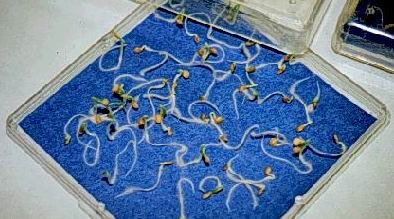Betty Jakum
Adams County Master Gardener
 Although still a bit early, many gardeners are itching to begin this year's growing season. Being able to safely plant seeds outdoors is still some time away, but it's not too early to assess seeds you have left over from past
seasons and order in new supplies if necessary.
Although still a bit early, many gardeners are itching to begin this year's growing season. Being able to safely plant seeds outdoors is still some time away, but it's not too early to assess seeds you have left over from past
seasons and order in new supplies if necessary.
It's not unusual for gardeners to find themselves with half-used and undated packets of favorite flower and vegetable varieties. If the seeds have been stored properly in a cool, dry place or airtight container, and properly treated with silica gel or some other desiccant if humidity is a problem,
it's a good chance that performing a simple seed germination test will give you an accurate assessment of your seeds' viability.
Viability is the seed's capability to grow and develop. One way to test a seed's viability, and thus avoid wasting time and garden space if the seeds prove to be no good, is to run a germination test. This involves little more than the seeds, some absorbent paper towels, water, a spray bottle, a
plastic zip bag and someplace warm.
|

An example of a very successful germination test where almost every seed has sprouted.
|
To test for germination, spread a paper towel on a water proof surface and wet down with warm water, using a spray bottle or some similar spraying device. Don't make the towel too wet. If water beads up around your fingertip when you press on the towel, it is too wet.
Ten seeds are sufficient to accurately test for germination, although you can use more if you have them. Evenly space the seeds on the paper towel keeping them about two inches from the edges. Carefully roll or fold them up in the towel so they are encased in a long, narrow strip of wet paper and
slip the whole thing into a plastic bag. Seal and mark it carefully, especially if more than one kind of seed or variety is being tested at the same time.
Place the bag in a warm spot like the top of a hot-water heater or refrigerator, near a wood stove or on a high shelf near a hot-air vent. The most rapid seed germination occurs when temperatures remain consistently between 70 and 80 degrees. Make sure the paper towel inside the plastic bag remains
damp during the entire testing period, moistening it if it shows signs of drying out.
Make the first germination check after two or three days. Keep checking at regular intervals to note the rate of seed germination. Once a day is not too often after germination begins. Most viable seeds will germinate within two to three weeks, and some will sprout much sooner. For example, seeds of
the cabbage family will often sprout in a few days while carrot seeds can take up to three weeks.
The test is completed when the majority of the seeds have germinated and several days have passed since the last sprouting. A germination rate of 70% or more indicates that the seeds are viable and can be planted normally in the garden. Any number below that should throw up a caution flag. This
doesn't mean that the seeds cannot be planted, only that they need to be given some extra considerations.
These seeds should be given high priority for planting in this year's garden as they will only be less viable next year. Some experts say that seeds lose 30% of their viability each year past their longevity dates. Another way these seeds can still be used successfully is to overplant them. Using
this technique, more seeds are planted in a given space increasing the germination rate significantly.
Seeds with germination rates of 30% or lower should probably be discarded. Not only will the germination rate be low, but even the seeds that do manage to sprout will probably be less vigorous and more prone to pests and diseases.
In deciding whether to use seeds from previous years, it is important to know seeds' various longevity dates. Below is a brief chart of some common vegetable seeds:
- One Year - onions, parsnips, parsley and spinach
- Two Years - corn, peas, beans, and okra
- Three Years - carrots, leeks, and turnips
- Four Years - peppers, chard, pumpkins, squash, and watermelons
- Five Years - most Cole family seeds (cabbage, cauliflower, etc), beets, tomatoes, eggplant, cucumbers, muskmelons, celery and lettuce.
The unsettled weather of mid Winter may keep gardeners from working outside, but now's a great time to get a jump start on the gardening season by checking the viability of seeds you already have. Finally, if you do find yourself in need of various vegetable and flower seeds, remember to order
early. Some seeds sell out quickly, and you don't want to miss out on your favorite varieties.
Read other articles on growing herbs or vegetables
Read other articles by Betty Jakum